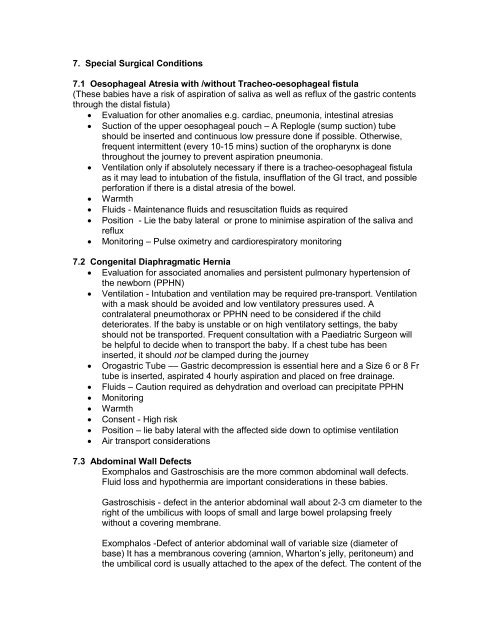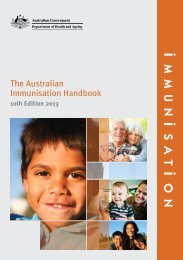Contents Chapter Topic Page Neonatology Respiratory Cardiology
Contents Chapter Topic Page Neonatology Respiratory Cardiology
Contents Chapter Topic Page Neonatology Respiratory Cardiology
Create successful ePaper yourself
Turn your PDF publications into a flip-book with our unique Google optimized e-Paper software.
7. Special Surgical Conditions<br />
7.1 Oesophageal Atresia with /without Tracheo-oesophageal fistula<br />
(These babies have a risk of aspiration of saliva as well as reflux of the gastric contents<br />
through the distal fistula)<br />
• Evaluation for other anomalies e.g. cardiac, pneumonia, intestinal atresias<br />
• Suction of the upper oesophageal pouch – A Replogle (sump suction) tube<br />
should be inserted and continuous low pressure done if possible. Otherwise,<br />
frequent intermittent (every 10-15 mins) suction of the oropharynx is done<br />
throughout the journey to prevent aspiration pneumonia.<br />
• Ventilation only if absolutely necessary if there is a tracheo-oesophageal fistula<br />
as it may lead to intubation of the fistula, insufflation of the GI tract, and possible<br />
perforation if there is a distal atresia of the bowel.<br />
• Warmth<br />
• Fluids - Maintenance fluids and resuscitation fluids as required<br />
• Position - Lie the baby lateral or prone to minimise aspiration of the saliva and<br />
reflux<br />
• Monitoring – Pulse oximetry and cardiorespiratory monitoring<br />
7.2 Congenital Diaphragmatic Hernia<br />
• Evaluation for associated anomalies and persistent pulmonary hypertension of<br />
the newborn (PPHN)<br />
• Ventilation - Intubation and ventilation may be required pre-transport. Ventilation<br />
with a mask should be avoided and low ventilatory pressures used. A<br />
contralateral pneumothorax or PPHN need to be considered if the child<br />
deteriorates. If the baby is unstable or on high ventilatory settings, the baby<br />
should not be transported. Frequent consultation with a Paediatric Surgeon will<br />
be helpful to decide when to transport the baby. If a chest tube has been<br />
inserted, it should not be clamped during the journey<br />
• Orogastric Tube –– Gastric decompression is essential here and a Size 6 or 8 Fr<br />
tube is inserted, aspirated 4 hourly aspiration and placed on free drainage.<br />
• Fluids – Caution required as dehydration and overload can precipitate PPHN<br />
• Monitoring<br />
• Warmth<br />
• Consent - High risk<br />
• Position – lie baby lateral with the affected side down to optimise ventilation<br />
• Air transport considerations<br />
7.3 Abdominal Wall Defects<br />
Exomphalos and Gastroschisis are the more common abdominal wall defects.<br />
Fluid loss and hypothermia are important considerations in these babies.<br />
Gastroschisis - defect in the anterior abdominal wall about 2-3 cm diameter to the<br />
right of the umbilicus with loops of small and large bowel prolapsing freely<br />
without a covering membrane.<br />
Exomphalos -Defect of anterior abdominal wall of variable size (diameter of<br />
base) It has a membranous covering (amnion, Wharton’s jelly, peritoneum) and<br />
the umbilical cord is usually attached to the apex of the defect. The content of the
















